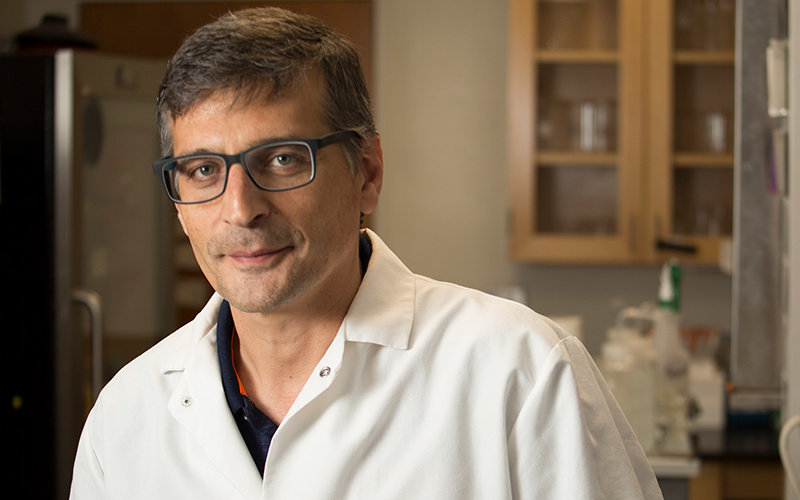
Molecular scientist Nikolas Nikolaidis and his students have discovered how a certain protein travels within stressed cells and cancer cells — a finding that could lead to new cancer therapeutics.
Nikolaidis relayed that their groundbreaking research is a tale of a molecule called heat-shock protein or Hsp70 (HSPA1A), found in the wrong place at the wrong time.
Their research describes the journey of the protein, which travels from inside the cell to the cell surface, or plasma membrane, and beyond in cancer and stressed cells. The protein is present in cells exposed to stress, such as in fevers, toxins or pathophysiological conditions like cancer.
Inside all cancer cells, this protein helps the cell survive. However, it also is present in the surface of 80% of tumors, Nikolaidis explained.
“The presence of this protein at the cell surface allows cancer cells to resist radiation therapy, increase their invasiveness and develop distant metastasis,” added Nikolaidis, professor of biological science. “Therefore, stopping the protein from being there is a promising new treatment suitable for several cancer types.”
Their research focuses on defining how and why this protein, which function to keep the cell alive, travels to the surface of cancer and stressed cells. The goal is the development of drugs that alter the location of the protein and activate the immune system to attack the cancer.
“Our most recent work describes an important part of this mechanism, which includes the interaction of the protein with specific membrane lipids,” Nikolaidis said. “The complete characterization of this mechanism would be of importance towards new, universal cancer therapeutics.”
Their latest research finding is described in a new paper published in Biomolecules, a peer-reviewed scientific and open-access journal. The researchers uncovered that inside the cell, the protein binds to a particular lipid called phosphatidylserine.
“We found that this binding is important, if not critical, to the movement of the protein to the cell surface. Our published work delineates a major part of the pathway that this protein uses to travel and anchor at the cell membrane.”
Biology graduate student Larissa Smulders and alumnus Andrei D. Bilog ’19 ‘15 (M.S. biology, B.S. biological science-cell and developmental biology) are lead authors of the paper. Nikolaidis, undergraduate biological science major Julianne Zapanta and alumni Ryan Oliverio ’18 (M.S. biology) and Cedra Labanieh ‘18 (B.S. biological science) are co-authors. Another co-author is Robert V. Stahelin, an expert in lipid biology and professor of medicinal chemistry and molecular pharmacology at Purdue University, who the CSUF researchers collaborated with on the study.
This is Smulders’ first published paper and her work will be reflected in her graduate thesis, which she expects to complete in fall. Her thesis focuses on the protein’s interaction with different membrane lipids.
“My thesis aims to shed light on the pathway that allows this protein to bind to the cell membrane, which protects the cell and renders cancer cells resistant to radiation therapy,” Smulders said.
“If we understand the regulation of the pathway, we might be able to develop a drug to manipulate whether the protein Hsp70 moves to the cell membrane or is secreted from the cell, and activates the immune system to attack cancerous cells.”
Smulders, who earned a bachelor’s degree in biology from the University of Bremen in Germany, plans to pursue a doctorate in molecular biology after she completes the graduate program in December. She has presented her research at state and national conferences and is the recipient of the 2019 Coppel Graduate Science Award from the College of Natural Sciences and Mathematics.
“During my time at Cal State Fullerton, I’ve not only boosted my competences as a scientist, but I’ve also gained valuable skills by being part of a research team. I’m excited about this project since it potentially might help to develop better medicine.”
Nikolaidis and his students are continuing work on the research to further describe other lipids important for the protein’s movement. The professor is optimistic about the study’s potential applications in the fields of biology and medicine.
“Collectively, our findings constitute the basic initial steps towards elucidating the unconventional ability of a very important protein and its implications to human health and disease,” he said.